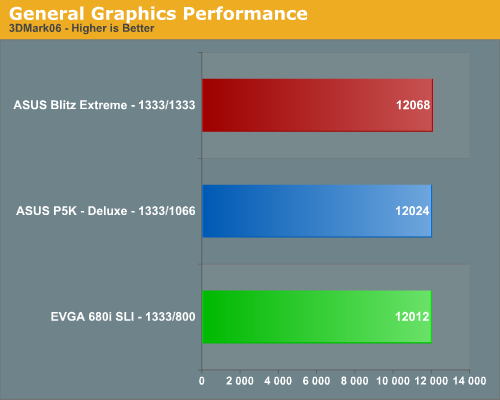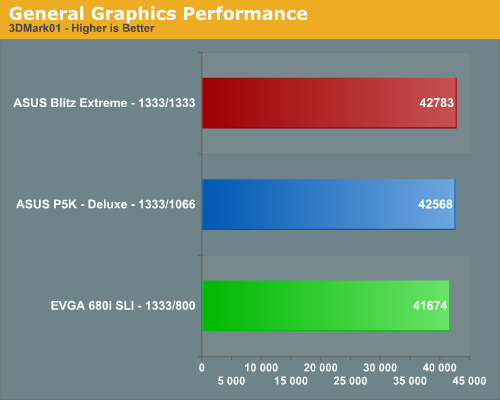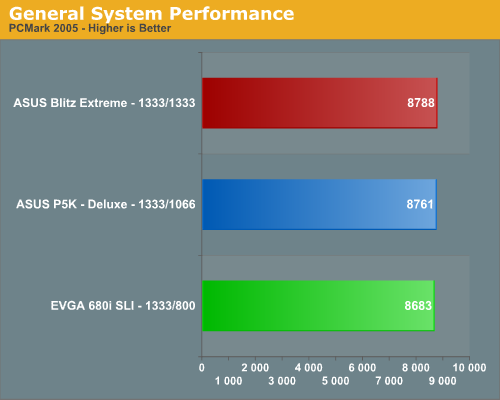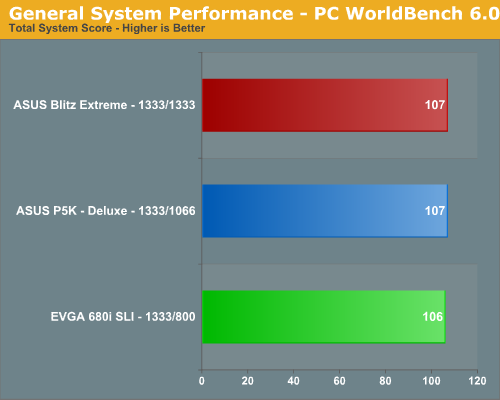NVIDIA 680i SLI: Official 1333MHz FSB CPU Support Arrives
by Gary Key on July 20, 2007 12:01 AM EST- Posted in
- CPUs
Synthetic Graphics Performance:
The 3DMark series of benchmarks developed and provided by Futuremark are among the most widely used tools for benchmark reporting and comparisons. Although the benchmarks are very useful for providing apples-to-apples comparisons across a broad array of GPU and CPU configurations they are not a substitute for actual application and gaming benchmarks. In this sense we consider the 3DMark benchmarks to be purely synthetic in nature but still very valuable for providing consistent measurements of performance.


In our 3DMark06 test, all of the boards are bunched together with a 0.004% spread from top to bottom. In essence all of the boards perform equally from a total score viewpoint. The Intel boards had a 1.8% advantage in the CPU tests while the NV board had a 1.67% advantage in the Graphics section of the test. This will be a familiar pattern in our limited benchmark results today.
In the more memory/CPU throughput sensitive 3DMark01 benchmark we see our Intel boards taking top honors. The spread is only 2.6%, however, so minor differences in performance are not really noticeable in either 3DMark unless you count on the differences for benchmark scores.
General System Performance
The PCMark05 benchmark developed and provided by Futuremark was designed for determining overall system performance for the typical home computing user. This tool provides both system and component level benchmarking results utilizing subsets of real world applications or programs. This benchmark is useful for providing comparative results across a broad array of Graphics, CPU, Hard Disk, and Memory configurations along with multithreading results. In this sense we consider the PCMark benchmark to be both synthetic and real world in nature, and it again provides for consistency in our benchmark results.

The ASUS boards have always done well in this benchmark due to very strong multitasking performance and the same holds true once again with our EVGA board trailing by only 1%. In the individual tests that make up this benchmark, the Intel chipsets scored the best in the CPU and memory sections while the NVIDIA based board had top honors in the graphics and hard disk tests.
The PC WorldBench 6.0 test suite developed and provided by PCWorld is designed for determining overall system performance for the home office user. This tool provides results for 10 different real world applications that range from Adobe Photoshop to AutoDesk 3ds Max. This benchmark is useful for providing comparative results across a broad array of Graphics, CPU, Hard Disk, and Memory configurations.

Once again, we see the Intel P35 chipsets scoring just slightly better than the NVIDIA 680i although the difference is absolutely minimal. Within the individual test scores the same pattern holds true with the Intel chipsets taking top honors in the CPU intensive benchmarks and NVIDIA placing first in the graphic and storage system intensive applications. In fact, if it were not for the 15% lower score in the Nero Recode test, we believe the EVGA board would have had the top overall score.
The 3DMark series of benchmarks developed and provided by Futuremark are among the most widely used tools for benchmark reporting and comparisons. Although the benchmarks are very useful for providing apples-to-apples comparisons across a broad array of GPU and CPU configurations they are not a substitute for actual application and gaming benchmarks. In this sense we consider the 3DMark benchmarks to be purely synthetic in nature but still very valuable for providing consistent measurements of performance.


In our 3DMark06 test, all of the boards are bunched together with a 0.004% spread from top to bottom. In essence all of the boards perform equally from a total score viewpoint. The Intel boards had a 1.8% advantage in the CPU tests while the NV board had a 1.67% advantage in the Graphics section of the test. This will be a familiar pattern in our limited benchmark results today.
In the more memory/CPU throughput sensitive 3DMark01 benchmark we see our Intel boards taking top honors. The spread is only 2.6%, however, so minor differences in performance are not really noticeable in either 3DMark unless you count on the differences for benchmark scores.
General System Performance
The PCMark05 benchmark developed and provided by Futuremark was designed for determining overall system performance for the typical home computing user. This tool provides both system and component level benchmarking results utilizing subsets of real world applications or programs. This benchmark is useful for providing comparative results across a broad array of Graphics, CPU, Hard Disk, and Memory configurations along with multithreading results. In this sense we consider the PCMark benchmark to be both synthetic and real world in nature, and it again provides for consistency in our benchmark results.

The ASUS boards have always done well in this benchmark due to very strong multitasking performance and the same holds true once again with our EVGA board trailing by only 1%. In the individual tests that make up this benchmark, the Intel chipsets scored the best in the CPU and memory sections while the NVIDIA based board had top honors in the graphics and hard disk tests.
The PC WorldBench 6.0 test suite developed and provided by PCWorld is designed for determining overall system performance for the home office user. This tool provides results for 10 different real world applications that range from Adobe Photoshop to AutoDesk 3ds Max. This benchmark is useful for providing comparative results across a broad array of Graphics, CPU, Hard Disk, and Memory configurations.

Once again, we see the Intel P35 chipsets scoring just slightly better than the NVIDIA 680i although the difference is absolutely minimal. Within the individual test scores the same pattern holds true with the Intel chipsets taking top honors in the CPU intensive benchmarks and NVIDIA placing first in the graphic and storage system intensive applications. In fact, if it were not for the 15% lower score in the Nero Recode test, we believe the EVGA board would have had the top overall score.










18 Comments
View All Comments
FireTech - Saturday, July 21, 2007 - link
Seconded.
Actually, it's over four months now. First post in http://forums.anandtech.com/messageview.aspx?catid...">mATX Roundup was on 15/03/07....
No matter, we do have another Intel focussed article to read while we wait for it ;)
DigitalFreak - Friday, July 20, 2007 - link
Good job! Want a cookie?
JKing76 - Friday, July 20, 2007 - link
No thanks, the thrice-promised uATX roundup would be fine.CrystalBay - Friday, July 20, 2007 - link
It must get really boring to keep testing MB's without much more than 2% performance differences.... Parity blows.....poohbear - Friday, July 20, 2007 - link
nice article, but the above was a bit much for a "professional" article. no offense, i like anantech for their technical knowledge not their ability to ramble on w/ half-hearted jokes. do i really need to read all that before understanding all u needed was a P35 board?
Chunga29 - Friday, July 20, 2007 - link
I actually thought the snarky comments at the beginning was the most enjoyable part. All NVIDIA's marketing hype kicking in bragging about their platform, when the reality is that it's nothing really special. The more pressing concern was the next sentence:Okay, so that's just one more reason to stick with XP for me, but seriously are you telling me that NVIDIA's launch Vista drivers were so perfect that no updates are necessary? I'd say their driver teams are probably overworked right now, but regardless if I were looking at Vista that situation wouldn't make me very happy.
BitJunkie - Friday, July 20, 2007 - link
I've had this board and a 7950GX2 card from nvidia since December 2006 with an E6600 plugged in to it. It's been stable at a 1333 FSB with memory running at 1066 since then all be it with slack 5-5-5-15 timings.On the whole it's a fast(ish) and stable system BUT....and it's a BIG but the drivers have been the weak link since I installed Vista in January. Not real change for me in that time, I STILL get BSOD'd regularly, the SLI functionality is borked for the gfx card and up until new BIOS my raid array keept locking up on boot.
Expecting them to deliver the goods for the newer 1333 fsb quad core CPUs is kind of like pissing in to the wind. I so hope amd / ati get their act together soon, this is getting old.
Sunrise089 - Friday, July 20, 2007 - link
Agreed - I can find benchmarks anywhere, and this sort of article (unlike say the memory wall one) doesn't require a lot of technical expertise - so why not liven it up a bit.